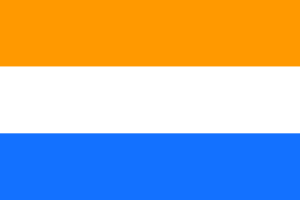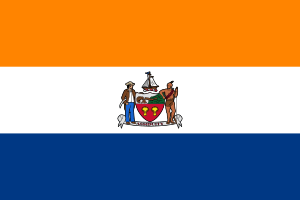Prince's Flag



The Prince's Flag (Dutch: Prinsenvlag, German: Prinzenflagge) is a Dutch historical flag, originally used by the Dutch Republic during the Eighty Years War, as observed during the first battle of Den Briel. The Prince's Flag is based on the Flag of Prince William of Orange-Nassau, hence the name. The colours are orange, white and blue, which is why the flag is often called oranje-blanje-bleu (or even: ranje-blanje-bleu) in Dutch, and orange-weiß-blau in German. The colour orange represents the Principality of Orange which Prince William inherited from René of Chalon, the white stripe represents the struggle for freedom and supremacy, and the blue colour is the signature colour of the former County of Nassau.
History
The Prince's Flag was first introduced by Sea Beggars in the Capture of Brielle in 1572. In 1587, the Admiralty of Zeeland ordered these flags to fly on their warships. It soon became a symbol of the Dutch Revolt and was adopted by the Dutch Republic. The orange in the flag gradually changed to red around 1650, becoming the flag of the Netherlands still in use today. The reason for this is unknown, although several theories exist.[1] The orange-white-blue flag, however, continued to be flown as well and in later times formed the basis for the former South African flag. It is also the basis for the flags of New York City and Albany, New York. After the republican Patriots, aided by the French, seized control over the Netherlands in 1795, the Prince's Flag was forbidden and the red-white-blue flag became the only official flag, to the content of the French, analogous as they were to their own tricolour, chosen just a few months earlier. In the following period of the Kingdom of Holland, there was also no place for Orange and the Bonapartist King Louis I chose red.
In 1813, when the French were expelled and the Netherlands regained its independence, the Prince of Orange returned to the country from England. The Prince's Flag saw a short revival; in order to demonstrate the attachment of the people to the House of Orange, both this flag and the red-white-blue flag fluttered on the roofs. In the same year, for the first time, the red-white-blue flag was flown with an orange pennant, which has remained the custom in the Netherlands. Whether the Prince's Flag or the red-white-blue flag should be the national flag was left undecided, although the Prince of Orange, later King William I, preferred the latter. In the 1930s, the supporters of the Nazi NSB considered the Prince's Flag the Netherlands' true flag.[2] On February 19, 1937, a Royal Decree issued by Queen Wilhelmina finally laid down the red, white and blue colours as the national flag (heraldic colours of bright vermilion, white and cobalt blue).[3]
Contemporary use
Today, the Prince's Flag is used in settings with particular nostalgia and historic national sentiment. The flag is for example raised from the old Matthias church tower in Warmond, as part of a commemoration ceremony for the start of the Dutch Kingdom.[4] The flag is also used as a symbol of the Greater Netherlands and Dutch pan-nationalist politics. It is frequently used by right-wing parties such as the Dutch People's Union (NVU)[5] and Voorpost,[6] as well as the (now defunct) Nationalist People's Movement (NVB).[7]
In 2011, two members of parliament for the Party for Freedom (PVV) had the Prince's flag hanging in their offices in the parliament's building. When this was received with scrutiny, the flags were removed. Former Dutch MP Wim Kortenoeven said he regrets that the flag has some negative connotations because it has been hijacked by the NSB in war-time Netherlands. The party denounces the defunct NSB and far-right movements.[8] At a PVV protest on 21 September 2013 in The Hague, several attendants were carrying Prince's flags. When Geert Wilders was speaking in House of Representatives the same week, Alexander Pechtold referred to the flags as 'NSB-flags', to which Wilders called Pechtold a sad, measly, hypocritical little man.[9][10] In protest of this remark, at least five members of the House of Representatives, Martin Bosma, Reinette Klever, Machiel de Graaf, Harm Beertema and Barry Madlener wore a Prince's flag lapel pin.[11][12]
Legacy
The Prince's Flag served as the basis for the earlier flag of South Africa. This flag was adopted in 1928 and was inspired by the former Dutch flag. In the white part of the flag are the flags of (left to right) the United Kingdom, the Orange Free State and Transvaal, representing the Union of South Africa's British colonial and republican predecessor states. In 1994 the flag was replaced by the current flag of South Africa.
As a consequence of its beginnings as the Dutch colony of New Netherland, several places in New York State use variants of the Prinsenvlag as their official flags. These places include New York City, The Bronx, Albany and Nassau County (Long Island).
-

Flag of Orange Free State (1854-1910)
-

Naval jack Brielse Geus
-

Variant on the Prince's flag
-

Flag of Hofstra University
See also
References
- ↑ "Prinsenvlag is omstreden, maar kent lange historie" (in Dutch). Retrieved 30 June 2014.
- ↑ "Prinsenvlag is omstreden, maar kent lange historie". Volkskrant (in Dutch). Retrieved 13 August 2014.
- ↑ "Flag Decree by Queen Wilhelmina". Flags of the World. 19 February 1937. Retrieved 2008-03-03.
- ↑ Warmond viert 200 jaar Koninkrijk groots, geplaatst op 02-12-2013
- ↑ "NVU protest walk with Prince's Flag prominently carried". Retrieved 2013-10-06.
- ↑ Webbreezer Solutions. "voorpost.org". voorpost.org. Retrieved 2013-10-06.
- ↑ "NVB order form listing the Prince's Flag with a lion on it". nationalistischevolksbeweging.nl.
- ↑ PVV member of parliament: Prince's Flag is a flag to be proud of, Algemeen Dagblad, May 11, 2011.
- ↑ Teruglezen: Wilders noemt Pechtold en Slob 'zielig en miezerig'
- ↑ Rel om Prinsenvlag
- ↑ PVV'ers in Tweede Kamer met omstreden Prinsenvlag, NRC handelsblad, 25 september 2013
- ↑ see photograph on 7:47, Pownews 26 september 2013
.svg.png)


